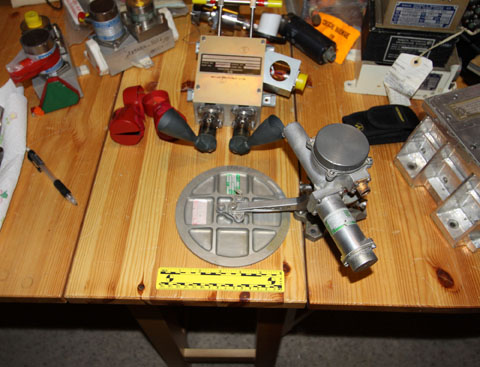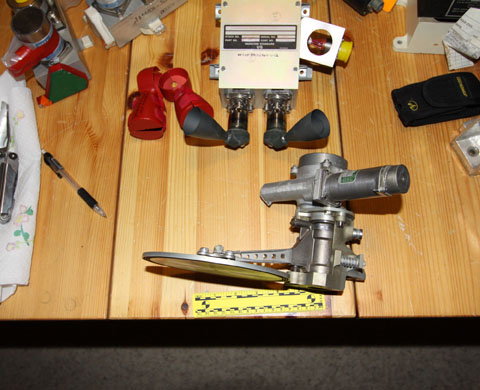|
Author
|
Topic: Dick Gordon on LM leg design, CM atmosphere
|
Gurbir
Member Posts: 41
From: UK
Registered: Oct 2010
|
 posted 04-23-2011 08:00 AM
posted 04-23-2011 08:00 AM
   
I know there are some extremely experienced members in this forum. I have a couple of questions that came out of Dick Gordon's visit to Pontefract: - During my brief interview (link), I asked him why the LEM was designed with four legs and not three. Dick explained that he had never had satisfactory answer himself and before sharing his thoughts. Anyone come across a detailed treatment of that issue?
- During the public Q&A he stated that the command module at time of splashdown had a 100% Oxygen atmosphere (at 5psi). Were partial pressures deemed OK? I understood that a 100% oxygen atmosphere was prohibited following the Apollo 1 fire. Was that not so?
|
nasamad
Member Posts: 2141
From: Essex, UK
Registered: Jul 2001
|
 posted 04-23-2011 08:24 AM
posted 04-23-2011 08:24 AM
   
If I recall correctly there were studies done with LEMs having varying numbers of legs, I have seen models with three and five legs, but not sure if I can remember six legs. Anyway, I believe four legs gave the more stability than three in the event of a large amount of horizontal velocity during the landing. I think there were a lot of tradeoffs during the design and testing phase of the LEM and this was a trade off between a safer landing over a lighter design of three legs.I don't have my books or the links handy at the moment but would have thought there would be some discussion on this in the Apollo Chronologies or Apollo Experience Reports. |
Sy Liebergot
Member Posts: 501
From: Pearland, Texas USA
Registered: May 2003
|
 posted 04-23-2011 08:52 AM
posted 04-23-2011 08:52 AM
   
quote:
Originally posted by Gurbir:
I understood that a 100% oxygen atmosphere was prohibited following the Apollo 1 fire. Was that not so?[/list]
After the Apollo 1 fire, the CM was launched with a cabin atmosphere of 60%N2/40%O2, which was replenished with pure O2 until the cabin was at 100% O2 at 5psi. During re-entry the CM side hatch pressure equalization valve began to open at 23.5K feet and inflow to equalize the cabin with the outside atmosphere. If not by 17K feet, the crew was to open the valve manually. So, the CM splashed down with a cabin atmosphere of air at 14.7 psi. BTW, the LM was launched with air in the cabin and which was allowed to vent to zero during ascent. It was repressed from the CM through the forward hatch so that it would be at least 93% O2 by the time lunar orbit was achieved. The procedure was called LM Enrichment. I hope this helps. |
SpaceAholic
Member Posts: 4494
From: Sierra Vista, Arizona
Registered: Nov 1999
|
 posted 04-23-2011 08:55 AM
posted 04-23-2011 08:55 AM
   
quote:
Originally posted by Gurbir:
I asked him why the LEM was designed with four legs and not three.
Stability trade off. Three leg configuration is inherently less so under a variety of landing scenarios - to achieve a similar level of stability with three legs they would need to be longer and larger to yield a wider spread and address transmitted loads during landing; leg space contraction was an issue - the SLA stowage envelope imposed restrictions on the maximum length and diameter of the legs. quote:
Were partial pressures deemed OK?
PPO2 of 5 PSIA was standard during the mission. |
SpaceAholic
Member Posts: 4494
From: Sierra Vista, Arizona
Registered: Nov 1999
|
 posted 04-23-2011 10:28 AM
posted 04-23-2011 10:28 AM
   
quote:
Originally posted by Sy Liebergot:
During re-entry the CM side hatch pressure equalization valve began to open at 23.5K feet and inflow to equalize the cabin with the outside atmosphere. If not by 17K feet, the crew was to open the valve manually. So, the CM splashed down with a cabin atmosphere of air at 14.7 psi.
There was also an additional set of valves - the PLV (Post Landing Ventilation) valve system located on the bulkhead behind the Main Display Console (MDC) which supported restoration of ground atmosphere inside the flight vehicle - example below:  
|
Sy Liebergot
Member Posts: 501
From: Pearland, Texas USA
Registered: May 2003
|
 posted 04-23-2011 12:28 PM
posted 04-23-2011 12:28 PM
   
Yes, they closed the dump valve and opened the PLV, postlanding. |
music_space
Member Posts: 1179
From: Canada
Registered: Jul 2001
|
 posted 04-24-2011 01:20 AM
posted 04-24-2011 01:20 AM
   
So, which one of those two valves allowed RCS fumes inside ASTP's CM before splashdown? |
Sy Liebergot
Member Posts: 501
From: Pearland, Texas USA
Registered: May 2003
|
 posted 04-24-2011 07:36 AM
posted 04-24-2011 07:36 AM
   
The side hatch equalization valve. The ELS switches were not actuated to preclude the RCS problem. |
MadSci
Member Posts: 230
From: Maryland, USA
Registered: Oct 2008
|
 posted 04-25-2011 06:24 PM
posted 04-25-2011 06:24 PM
  
I have read in various sources that the five leg configuration was considered the best overall, however Grumman had to reduce the number of legs for - you guessed it - weight reduction.As Scott pointed out, the choice was then between three or four legs, and three was just too unstable and would therefore require a very large span, which would not fit in the SLA and would tend to counteract the weight loss attained by reducing the number of legs. By the way, Scott - you're the only person I know with the chopps to augment a description by Sy! As usual, the incredible array of knowledge and talents here at cS leaves me amazed, humble and grateful. By the way, that's the official NASA line if you are ever interviewed by a reporter about cS: "Well I'm amazed, and humbled - and grateful!"  |
Aero_John
New Member Posts:
From:
Registered:
|
 posted 04-25-2011 08:55 PM
posted 04-25-2011 08:55 PM
   
Tom Kelly's excellent book "Moon Lander: How We Developed the Apollo Lunar Module" has several pages devoted to the derivation of the landing gear design. They started with five fixed gear and during design iterations wound up with a cruciform descent stage which was well suited for four landing gear. If you haven't read this book, it's one of my top 10 for it's frank and unassuming discussion of the history of the LM development and the challenges encountered. Mr. Kelly was one of the great ones... |
MCroft04
Member Posts: 1647
From: Smithfield, Me, USA
Registered: Mar 2005
|
 posted 04-26-2011 09:16 PM
posted 04-26-2011 09:16 PM
   
Aero_John. I agree "Moon Lander" is a great book. Welcome to cS! |














